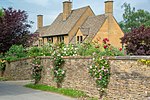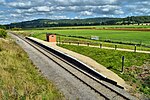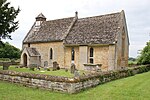Stanway House

Stanway House is a Jacobean manor house near the village of Stanway in Gloucestershire, England. The manor of Stanway was owned by Tewkesbury Abbey for 800 years, then for 500 years by the Tracy family and their descendants, the Earls of Wemyss and March. Stanway House, originally constructed in the late 16th and early 17th century for the Tracy family, is a Grade I listed building. The principal rooms are in a long south-facing range forming an L-shape with the hall, unlike the usual Tudor house plan of a central hall. The north-east wing, remodelled in 1913 by Detmar Blow, was demolished in 1948. The kitchen court was designed by William Burn in 1859. The Gatehouse was built in about 1630. The construction includes Guiting yellow stone and some Jacobean mullions and gables. Owner James Charteris, then Lord Neidpath, now the 13th Earl of Wemyss and March, has pursued a programme of restoration for a number of years. The house and grounds are open to the public on a limited basis each summer.
Excerpt from the Wikipedia article Stanway House (License: CC BY-SA 3.0, Authors, Images).Stanway House
Cockpit, Tewkesbury Stanway
Geographical coordinates (GPS) Address Website External links Nearby Places Show on map
Geographical coordinates (GPS)
| Latitude | Longitude |
|---|---|
| N 51.9899 ° | E -1.9122 ° |
Address
Stanway House
Cockpit
GL54 5PQ Tewkesbury, Stanway
England, United Kingdom
Open on Google Maps










